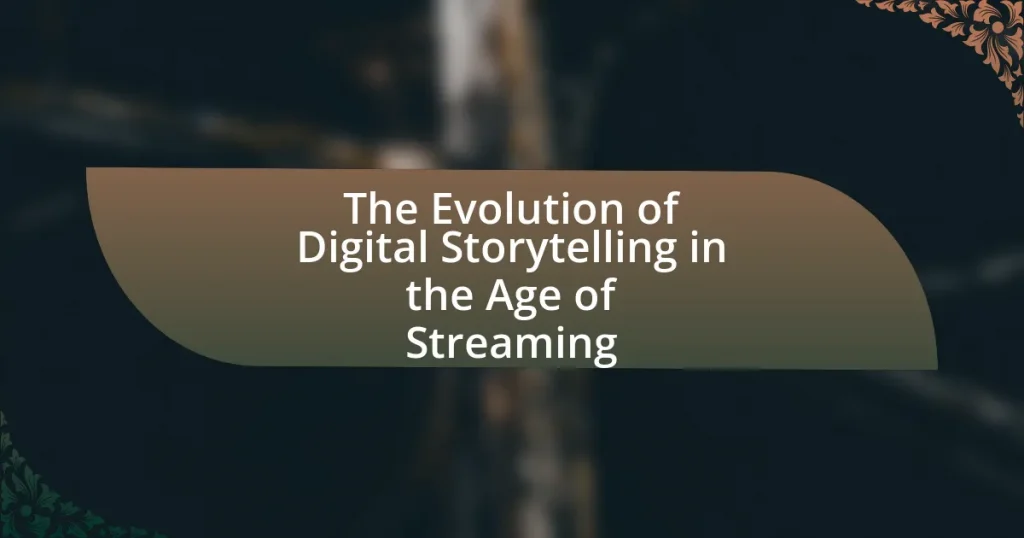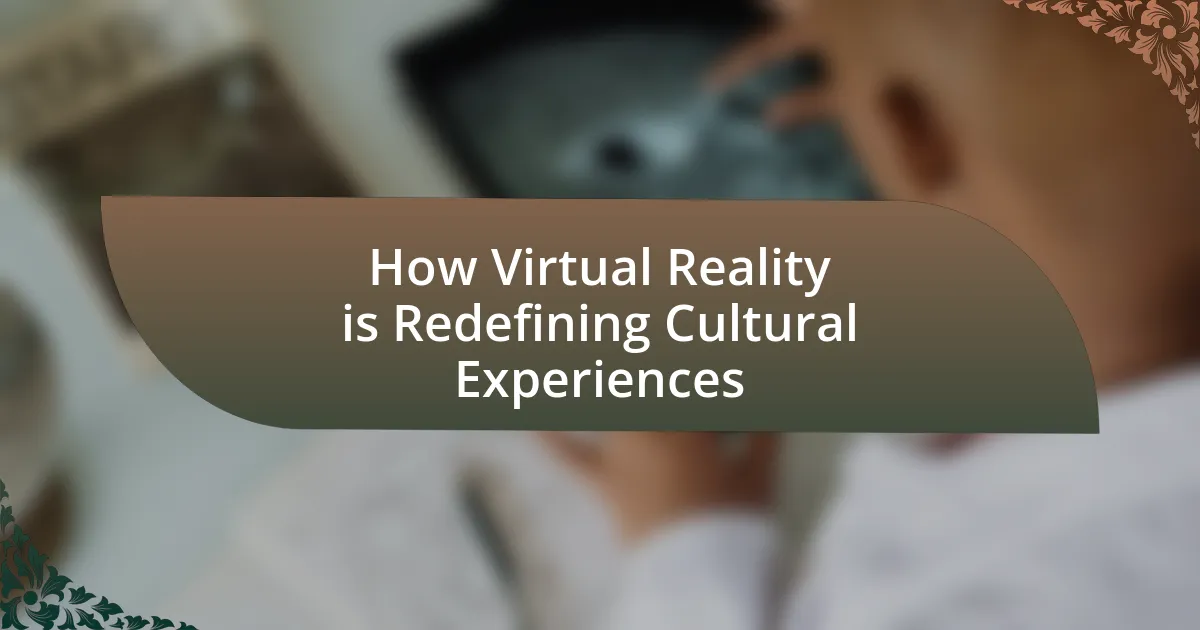The article examines the evolution of digital storytelling in the age of streaming, highlighting how platforms like Netflix and Hulu have transformed narrative techniques and audience engagement. It discusses the shift from traditional episodic formats to binge-watching experiences, allowing for deeper character development and complex narratives, as seen in successful series like “Stranger Things.” The rise of interactive storytelling and the democratization of content creation are also explored, emphasizing the importance of diverse voices and cultural representation. Key characteristics of digital storytelling, including interactivity, multimedia integration, and audience engagement, are analyzed, along with the impact of technological advancements on narrative structures and viewer experiences.
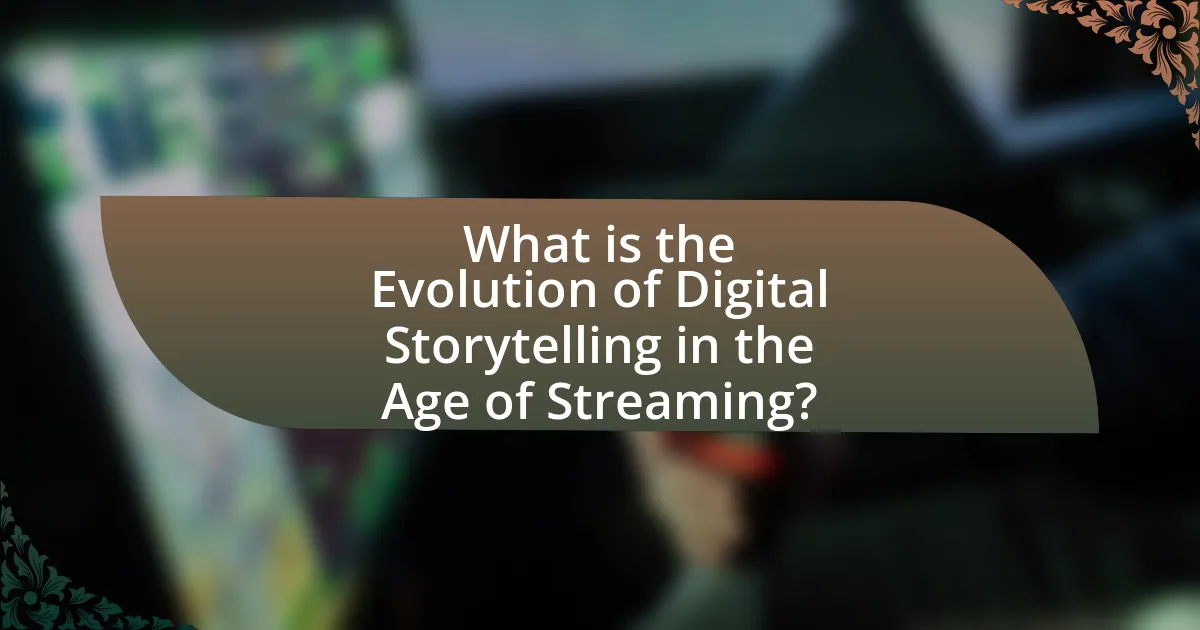
What is the Evolution of Digital Storytelling in the Age of Streaming?
The evolution of digital storytelling in the age of streaming has transformed narrative techniques and audience engagement. Streaming platforms like Netflix and Hulu have shifted storytelling from traditional episodic formats to binge-watching experiences, allowing for deeper character development and complex narratives. This change is evidenced by the success of series such as “Stranger Things,” which utilizes cliffhangers and interconnected story arcs to maintain viewer interest across multiple episodes. Additionally, the rise of interactive storytelling, as seen in projects like “Bandersnatch,” showcases how streaming technology enables viewers to influence plot outcomes, further enhancing engagement. The accessibility of streaming services has democratized content creation, allowing diverse voices to emerge and reshape narratives, as demonstrated by shows like “Pose,” which highlights underrepresented communities. Overall, the age of streaming has redefined how stories are told and consumed, emphasizing immediacy, interactivity, and inclusivity.
How has digital storytelling transformed with the rise of streaming platforms?
Digital storytelling has transformed significantly with the rise of streaming platforms by enabling diverse narrative formats and enhancing audience engagement. Streaming services like Netflix and Amazon Prime Video have shifted storytelling from traditional episodic formats to binge-worthy series, allowing for deeper character development and complex plots. This transformation is evidenced by the success of shows like “Stranger Things,” which utilizes cliffhangers and serialized storytelling to keep viewers invested. Additionally, streaming platforms have democratized content creation, allowing independent creators to reach global audiences, as seen with platforms like YouTube and Vimeo. This shift has led to a broader range of voices and stories being told, reflecting diverse cultural perspectives and experiences.
What are the key characteristics of digital storytelling in this context?
The key characteristics of digital storytelling in the context of streaming include interactivity, multimedia integration, and audience engagement. Interactivity allows viewers to influence the narrative through choices, enhancing immersion. Multimedia integration combines text, audio, video, and graphics to create a rich storytelling experience. Audience engagement is fostered through social media and community platforms, enabling viewers to share their interpretations and connect with creators. These characteristics reflect the shift towards a more participatory and dynamic storytelling approach in the streaming era.
How do streaming platforms influence narrative structures in digital storytelling?
Streaming platforms significantly influence narrative structures in digital storytelling by enabling serialized content and non-linear storytelling. These platforms, such as Netflix and Amazon Prime, allow creators to develop complex narratives over multiple episodes, encouraging deeper character development and intricate plotlines. For instance, the success of shows like “Stranger Things” demonstrates how episodic formats can build suspense and engage audiences over time, contrasting with traditional one-off films. Additionally, streaming services often utilize data analytics to understand viewer preferences, which can lead to tailored narratives that resonate more effectively with specific audiences. This data-driven approach has been shown to impact the pacing and structure of stories, as creators adapt to viewer engagement patterns, further reshaping how narratives are constructed in the digital age.
Why is the evolution of digital storytelling significant today?
The evolution of digital storytelling is significant today because it transforms how narratives are created, shared, and consumed across various platforms. This shift enables greater accessibility and interactivity, allowing audiences to engage with stories in immersive ways, such as through virtual reality and interactive media. According to a report by the Interactive Advertising Bureau, 70% of consumers prefer video content over traditional text, highlighting the growing importance of digital formats in storytelling. Furthermore, the rise of streaming services has democratized content creation, empowering diverse voices and fostering innovation in narrative techniques.
What cultural shifts have accompanied the rise of streaming services?
The rise of streaming services has led to significant cultural shifts, including the decline of traditional television viewing and the emergence of binge-watching as a dominant consumption pattern. Traditional cable subscriptions have decreased by over 25% since 2015, as viewers increasingly prefer on-demand access to content. This shift has also fostered a more globalized viewing experience, allowing audiences to access diverse international content, which has influenced local cultures and viewing habits. Additionally, streaming platforms have changed the way stories are told, emphasizing serialized narratives and character development, which cater to audience engagement over episodic formats.
How does audience engagement differ in traditional versus streaming platforms?
Audience engagement significantly differs between traditional and streaming platforms, primarily due to the interactive capabilities of streaming services. Traditional platforms, such as television and radio, typically offer a one-way communication model where audiences passively consume content without immediate feedback or interaction. In contrast, streaming platforms like Netflix and Hulu allow for real-time engagement through features such as user ratings, comments, and social sharing, fostering a more interactive experience.
For instance, a 2021 report by Nielsen indicated that streaming platforms have seen a 60% increase in viewer interaction compared to traditional media, highlighting the shift towards a more participatory audience experience. This increased engagement is further supported by the ability of streaming services to provide personalized content recommendations based on viewer preferences, which traditional media lacks.
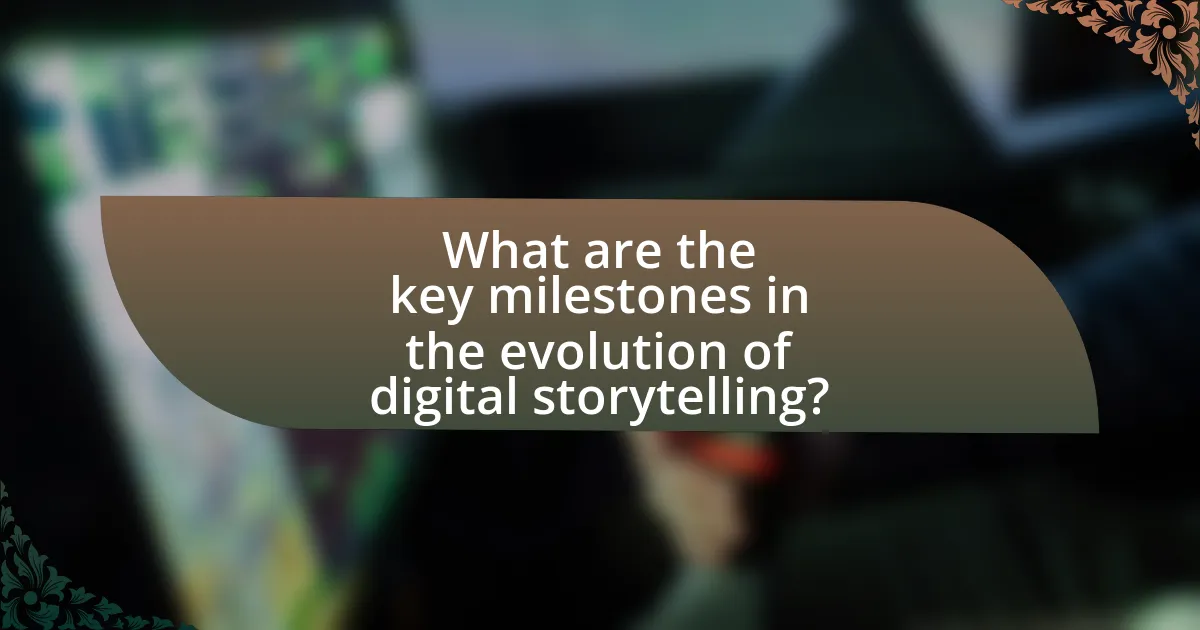
What are the key milestones in the evolution of digital storytelling?
The key milestones in the evolution of digital storytelling include the advent of the internet in the 1990s, the rise of social media platforms in the 2000s, and the emergence of streaming services in the 2010s. The internet enabled the first wave of digital narratives, allowing users to create and share stories online. Social media platforms like Facebook and Twitter transformed storytelling by facilitating real-time engagement and user-generated content. Streaming services such as Netflix and Hulu revolutionized the consumption of narratives, providing on-demand access to a vast array of content and enabling binge-watching culture. Each of these milestones significantly shaped how stories are created, shared, and consumed in the digital age.
How did early digital storytelling formats pave the way for streaming?
Early digital storytelling formats, such as web series and interactive narratives, laid the groundwork for streaming by introducing audiences to on-demand content consumption. These formats demonstrated the viability of distributing stories online, allowing viewers to engage with content at their convenience, which directly influenced the development of streaming platforms. For instance, the rise of platforms like YouTube in the mid-2000s showcased how serialized content could attract large audiences, prompting traditional media companies to adapt their distribution models. Additionally, early experiments with interactive storytelling, like those seen in video games and multimedia websites, highlighted the potential for viewer engagement, a key feature that streaming services later capitalized on to enhance user experience.
What role did the internet play in the development of digital narratives?
The internet significantly facilitated the development of digital narratives by providing a platform for widespread distribution and interactive engagement. It enabled creators to share stories globally, reaching diverse audiences without traditional publishing barriers. The rise of social media and user-generated content platforms, such as YouTube and Wattpad, further democratized storytelling, allowing individuals to contribute their narratives and receive immediate feedback. This shift has led to the emergence of new narrative forms, such as transmedia storytelling, where stories unfold across multiple platforms, enhancing audience immersion and participation. The internet’s role in fostering collaboration and community around storytelling has transformed how narratives are created, shared, and experienced.
How have technological advancements shaped storytelling techniques?
Technological advancements have significantly shaped storytelling techniques by enabling new forms of narrative delivery and audience engagement. The rise of digital platforms, such as streaming services, has facilitated interactive storytelling, allowing viewers to influence plot outcomes, as seen in projects like Netflix’s “Bandersnatch.” Additionally, advancements in virtual reality (VR) and augmented reality (AR) have created immersive experiences that transform traditional narratives into participatory events, enhancing emotional connection and engagement. Furthermore, data analytics tools allow creators to tailor content based on audience preferences, leading to more personalized storytelling. These developments illustrate how technology continuously redefines the boundaries and methods of storytelling in the digital age.
What are the major trends in digital storytelling on streaming platforms?
Major trends in digital storytelling on streaming platforms include interactive narratives, diverse representation, and binge-watching formats. Interactive narratives, exemplified by platforms like Netflix with “Bandersnatch,” allow viewers to make choices that influence the storyline, enhancing engagement. Diverse representation has become a priority, with streaming services increasingly showcasing stories from various cultures and backgrounds, as seen in series like “Never Have I Ever.” Additionally, the binge-watching format, popularized by the release of entire seasons at once, encourages deeper viewer immersion and fosters community discussions around shows, as evidenced by the success of series like “Stranger Things.” These trends reflect the evolving landscape of digital storytelling, driven by audience preferences and technological advancements.
How are interactive narratives changing the viewer experience?
Interactive narratives are transforming the viewer experience by allowing audiences to actively participate in the storytelling process. This engagement fosters a deeper emotional connection and investment in the narrative, as viewers can make choices that influence the plot and character outcomes. Research indicates that interactive storytelling can enhance user satisfaction and retention; for instance, a study published in the Journal of Interactive Media found that participants who engaged with interactive narratives reported higher levels of enjoyment and immersion compared to traditional linear formats. This shift in viewer agency not only alters how stories are consumed but also encourages a more personalized and dynamic interaction with content, reflecting the evolving landscape of digital storytelling in the streaming era.
What impact do user-generated content and social media have on storytelling?
User-generated content and social media significantly enhance storytelling by democratizing the narrative process and fostering community engagement. This shift allows diverse voices to contribute to stories, enriching the narrative landscape with varied perspectives. For instance, platforms like Instagram and TikTok enable users to share personal experiences and creative interpretations, which can influence mainstream narratives and trends. Research indicates that 79% of people say user-generated content highly impacts their purchasing decisions, demonstrating its power in shaping perceptions and stories around brands and experiences. This participatory approach not only broadens the scope of storytelling but also creates a more interactive and immersive experience for audiences.
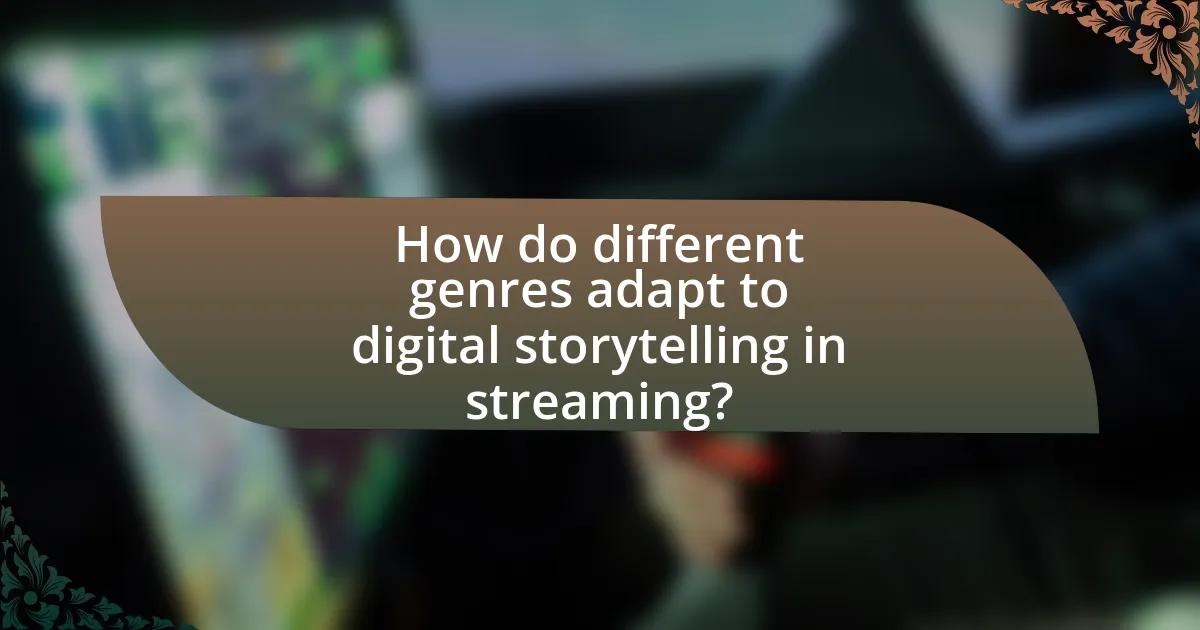
How do different genres adapt to digital storytelling in streaming?
Different genres adapt to digital storytelling in streaming by leveraging unique narrative structures, audience engagement techniques, and multimedia elements tailored to the platform’s capabilities. For instance, drama series often utilize episodic storytelling to develop complex characters over time, while documentaries may incorporate interactive features that allow viewers to explore topics in depth. Additionally, genres like horror capitalize on the immersive potential of streaming by employing cliffhangers and real-time viewer choices to enhance suspense. This adaptability is supported by data showing that streaming platforms have increased viewer retention by 30% through personalized content recommendations and genre-specific marketing strategies.
What unique challenges do genres face in the streaming environment?
Genres face unique challenges in the streaming environment primarily due to oversaturation and algorithm-driven content curation. The abundance of available content leads to genre fatigue, where audiences may become overwhelmed and disengaged from specific genres. Additionally, streaming platforms often rely on algorithms that prioritize popular or trending content, which can marginalize niche genres and limit their visibility. For instance, a report by Deloitte in 2021 indicated that 80% of viewers struggle to find new content that aligns with their interests, highlighting the difficulty for less mainstream genres to attract and retain audiences. This environment necessitates innovative marketing strategies and audience engagement techniques to ensure diverse genres can thrive amidst competition.
How do horror and thriller genres utilize digital storytelling techniques?
Horror and thriller genres utilize digital storytelling techniques by leveraging interactive elements, immersive sound design, and nonlinear narratives to enhance viewer engagement and emotional impact. Interactive platforms, such as choose-your-own-adventure formats, allow audiences to influence plot outcomes, creating a personalized experience that heightens suspense. Immersive sound design, including binaural audio, intensifies fear and tension by manipulating soundscapes to evoke visceral reactions. Nonlinear narratives, often seen in streaming series, enable complex storytelling that keeps viewers guessing and invested in character arcs. These techniques have been validated by studies showing that interactive and immersive experiences significantly increase viewer retention and emotional response, particularly in horror and thriller contexts.
What innovations are seen in comedy and drama through streaming platforms?
Streaming platforms have introduced several innovations in comedy and drama, primarily through diverse content formats, interactive storytelling, and data-driven personalization. These platforms enable creators to experiment with shorter episode lengths, allowing for more concise storytelling, as seen in series like “High Maintenance.” Additionally, interactive elements, such as Netflix’s “Bandersnatch,” allow viewers to influence the narrative, enhancing engagement. Data analytics also play a crucial role, as platforms utilize viewer preferences to tailor content recommendations, leading to the creation of niche genres and targeted programming, exemplified by shows like “Sex Education,” which addresses specific audience demographics.
How do creators approach storytelling differently for streaming audiences?
Creators approach storytelling for streaming audiences by emphasizing binge-worthy narratives that prioritize character development and plot arcs over episodic structures. This shift is driven by the consumption habits of viewers who prefer to watch multiple episodes in one sitting, leading creators to craft stories that maintain engagement across longer formats. For instance, series like “Stranger Things” and “The Crown” utilize cliffhangers and intricate character backstories to encourage continuous viewing, reflecting a strategic adaptation to the streaming model that contrasts with traditional television’s episodic storytelling.
What strategies do writers use to capture and retain viewer attention?
Writers use several strategies to capture and retain viewer attention, including compelling openings, relatable characters, and engaging narratives. Compelling openings, such as intriguing questions or dramatic scenes, immediately draw viewers in, while relatable characters foster emotional connections, making audiences more invested in the story. Engaging narratives that incorporate suspense, conflict, and resolution keep viewers interested throughout the piece. Research indicates that stories with strong emotional arcs can increase viewer retention by up to 70%, highlighting the effectiveness of these strategies in maintaining audience engagement.
How does pacing differ in streaming series compared to traditional formats?
Pacing in streaming series differs significantly from traditional formats primarily due to the absence of time constraints and the binge-watching model. Streaming series often allow for longer episodes and more character development, enabling creators to explore complex narratives at a more leisurely pace. In contrast, traditional formats, such as network television, typically adhere to strict time slots, necessitating tighter pacing and quicker plot resolutions to fit within commercial breaks and weekly schedules. This difference is evidenced by the rise of serialized storytelling in streaming platforms, where entire seasons are released simultaneously, allowing viewers to consume content at their own pace, which can lead to deeper engagement with the material.
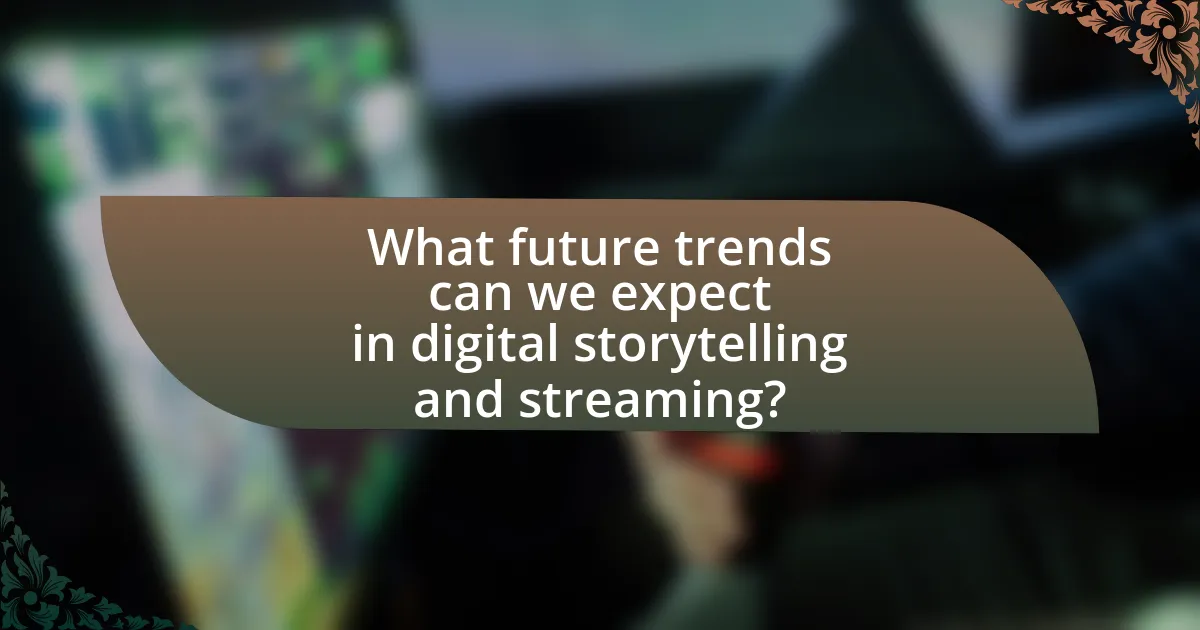
What future trends can we expect in digital storytelling and streaming?
Future trends in digital storytelling and streaming include increased interactivity, personalized content, and the integration of virtual and augmented reality. Interactivity will allow audiences to engage with narratives in real-time, as seen in platforms like Netflix experimenting with choose-your-own-adventure formats. Personalized content will leverage AI algorithms to tailor stories to individual viewer preferences, enhancing user experience and engagement. The integration of virtual and augmented reality will create immersive storytelling environments, as evidenced by projects like Oculus Story Studio, which have demonstrated the potential for deeper emotional connections through immersive experiences. These trends indicate a shift towards more engaging, tailored, and immersive storytelling methods in the streaming landscape.
How might emerging technologies influence the next phase of digital storytelling?
Emerging technologies will significantly influence the next phase of digital storytelling by enhancing interactivity, personalization, and immersive experiences. Technologies such as virtual reality (VR), augmented reality (AR), and artificial intelligence (AI) enable creators to craft narratives that engage audiences in novel ways. For instance, VR allows users to step into a story, experiencing it from within, while AR can overlay digital elements onto the real world, creating a blended storytelling experience. AI can analyze user preferences to tailor content, making stories more relevant and engaging. According to a report by PwC, the global VR and AR market is expected to reach $1.5 trillion by 2030, indicating a strong trend towards immersive storytelling. This integration of emerging technologies will redefine how stories are told and experienced, making them more dynamic and interactive.
What role will virtual reality and augmented reality play in storytelling?
Virtual reality (VR) and augmented reality (AR) will significantly enhance storytelling by creating immersive experiences that engage audiences on a deeper emotional level. These technologies allow users to interact with narratives in real-time, transforming passive consumption into active participation. For instance, VR can transport users into a story’s environment, enabling them to explore settings and interact with characters, while AR can overlay digital elements onto the real world, enriching the narrative context. Research by the University of Southern California found that immersive storytelling can increase emotional engagement by up to 30%, demonstrating the effectiveness of VR and AR in enhancing narrative experiences.
How could artificial intelligence shape narrative creation in the future?
Artificial intelligence could significantly shape narrative creation in the future by enabling personalized storytelling experiences. AI algorithms can analyze user preferences and behaviors to tailor narratives that resonate with individual audiences, enhancing engagement. For instance, Netflix employs AI to recommend content based on viewing history, which demonstrates how data-driven insights can influence narrative direction. Furthermore, AI tools like OpenAI’s GPT-3 can assist writers by generating plot ideas, character development, and dialogue, streamlining the creative process. This integration of AI not only fosters innovation in storytelling but also allows for the exploration of diverse narrative structures that adapt in real-time to audience reactions.
What best practices should creators follow in the age of streaming?
Creators should prioritize audience engagement and content quality in the age of streaming. Engaging with audiences through social media and interactive platforms fosters community and loyalty, which are crucial for success. Additionally, maintaining high production values and storytelling techniques enhances viewer experience, as evidenced by the rise of platforms like Netflix, which invests heavily in original content to attract and retain subscribers. Furthermore, understanding analytics and viewer preferences allows creators to tailor their content effectively, ensuring relevance in a competitive landscape.
How can understanding audience analytics improve storytelling effectiveness?
Understanding audience analytics enhances storytelling effectiveness by enabling creators to tailor narratives that resonate with specific viewer preferences and behaviors. By analyzing data such as viewer demographics, engagement rates, and content consumption patterns, storytellers can identify what elements captivate their audience. For instance, a study by Nielsen found that 70% of viewers are more likely to engage with content that reflects their interests and cultural backgrounds. This data-driven approach allows for the creation of more relevant and impactful stories, ultimately leading to higher viewer retention and satisfaction.
What are the key elements of successful digital storytelling in streaming?
The key elements of successful digital storytelling in streaming include engaging narratives, character development, interactivity, and visual aesthetics. Engaging narratives capture the audience’s attention and maintain interest, often utilizing cliffhangers or emotional arcs to enhance viewer investment. Character development allows viewers to form connections with the characters, making the story more relatable and impactful. Interactivity, such as audience choices or participation, fosters a deeper connection and personal investment in the story. Visual aesthetics, including cinematography and design, enhance the storytelling experience by creating an immersive environment that complements the narrative. These elements collectively contribute to a compelling and memorable streaming experience, as evidenced by successful series like “Stranger Things,” which effectively employs all these components to engage its audience.
